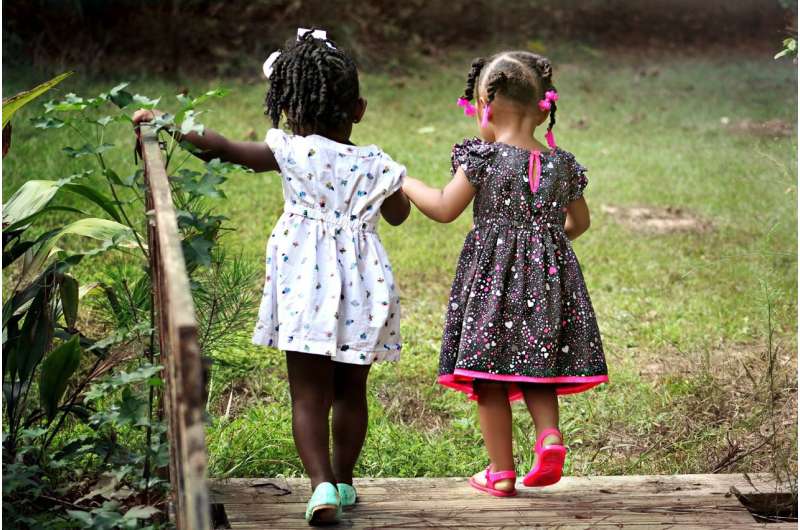This article has been reviewed according to Science X's editorial process and policies. Editors have highlighted the following attributes while ensuring the content's credibility:
fact-checked
reputable news agency
proofread
Wilms tumor: Kidney cancer in children

While kidney cancer is rare in children, Wilms tumor is the most common type found in kids, with between 500 and 600 children diagnosed annually in the U.S. The disease most often affects kids ages 3 to 4.
Thanks to advances in treatments over the past several decades, survival rates from this rare cancer have improved significantly. Developing a treatment plan customized for each child with Wilms tumor has also helped to improve the prognosis for children with this disease.
"Every Wilms tumor is different—in size, location, complexity, and whether it has spread to other organs," says Stephanie Polites, M.D., a Mayo Clinic pediatric surgeon. "Having a multidisciplinary team of health care professionals who can develop an individualized care plan for each child is key."
Here's what families should know about treatment for this rare childhood cancer:
A team approach is best
At Mayo Clinic, treatment for Wilms tumor is planned by a team of health care professionals from multiple specialties. "From the moment a child is diagnosed with a kidney tumor, our team meets to discuss the plan of attack," says Candace Granberg, M.D., a Mayo Clinic pediatric urologist.
Dr. Granberg is part of the pediatric solid tumor team at Mayo Clinic, which includes:
- Pediatric oncologists: Doctors who specialize in treating children and young adults who have cancer.
- Radiation oncologists: Doctors who specialize in treating cancer with radiation therapy, a type of cancer treatment that uses beams of intense energy—X-rays or protons—to kill cancer cells.
- Pediatric radiologists: Doctors who specialize in using imaging technology to diagnose and treat children with various conditions.
- Pediatric surgeons: Doctors who specialize in performing surgery in children.
- Pediatric urologists: Doctors who specialize in diagnosing and treating problems involving the male and female urinary tract and the male reproductive organs in children.
This team meets to review the needs of each child with Wilms tumor and determines the first step for treatment. "We coordinate care to streamline appointments and procedures to minimize the frequency of trips families must take," says Dr. Granberg.
Before starting treatment, your child's care team will determine if cancer treatment could affect the child's future fertility. If so, they offer the family options for fertility preservation. These options will depend on a child's age, puberty stage, diagnosis and proposed treatment plan.
At Mayo Clinic, procedures to preserve fertility are integrated with other treatment procedures or imaging scans whenever possible to minimize a child's exposure to anesthesia.
Surgeons need expertise in complex procedures
Treatment for Wilms tumor may begin with surgery to remove all or part of a kidney. At Mayo Clinic, pediatric radiologists construct life-size, anatomic 3D models of the Wilms tumor and surrounding structures to help with surgical planning. This approach is useful in challenging circumstances, such as removing only the part of the kidney containing the tumor (partial nephrectomy) or removing multiple tumors from one kidney.
Treatment often involves the surgical removal of the entire kidney and nearby lymph nodes through an incision in the abdomen. Given the substantial size of many Wilms tumors and their proximity to vital structures and organs, your child's pediatric surgical team needs to specialize in complex abdominal operations for children to ensure the best outcomes.
Sometimes, a tumor will extend into major blood vessels, and the approach requires the assistance of vascular surgeons who specialize in treating circulatory system diseases.
"We are blessed at Mayo Clinic to have these specialists right down the hall from our pediatric operating rooms. They bring their entire team to our room and either reconstruct the major vessels or place grafts if needed," says Dr. Granberg. "These are procedures they do all the time, so having them there for these rare cases in kids is necessary for a successful surgery."
Chemotherapy can be used before surgery to shrink tumors and make them easier to remove. After surgery, it can kill cancer cells left in the body. Chemotherapy may also be an option for children whose cancers are too far along to be removed completely with surgery.
New technology and research continue to improve treatment.
Radiation therapy may also be used to treat Wilms tumor. Radiation therapy most often uses X-rays to beam intense energy to kill cancer cells. Proton beam therapy, another important advancement in caring for children with Wilms tumor and other childhood cancers, may also be used. This highly targeted precision beam therapy destroys cancer while sparing healthy tissue. It's an important component of the treatment plan for children, as it prevents damage to developing organs and reduces long-term complications, side effects and secondary malignancies.
Research on Wilms tumor is ongoing, and Mayo Clinic researchers are studying new ways to treat this rare cancer. "Though a cure is possible in the majority of cases, we need to do better—we want to cure everyone," says Patricio Gargollo, M.D., a Mayo Clinic pediatric urologist.
Dr. Gargollo and his colleagues recommend seeking a children's cancer center with experience treating Wilms tumors. With the right care team, children with Wilms tumor can have excellent outcomes.
2024 Mayo Clinic News Network. Distributed by Tribune Content Agency, LLC.




















